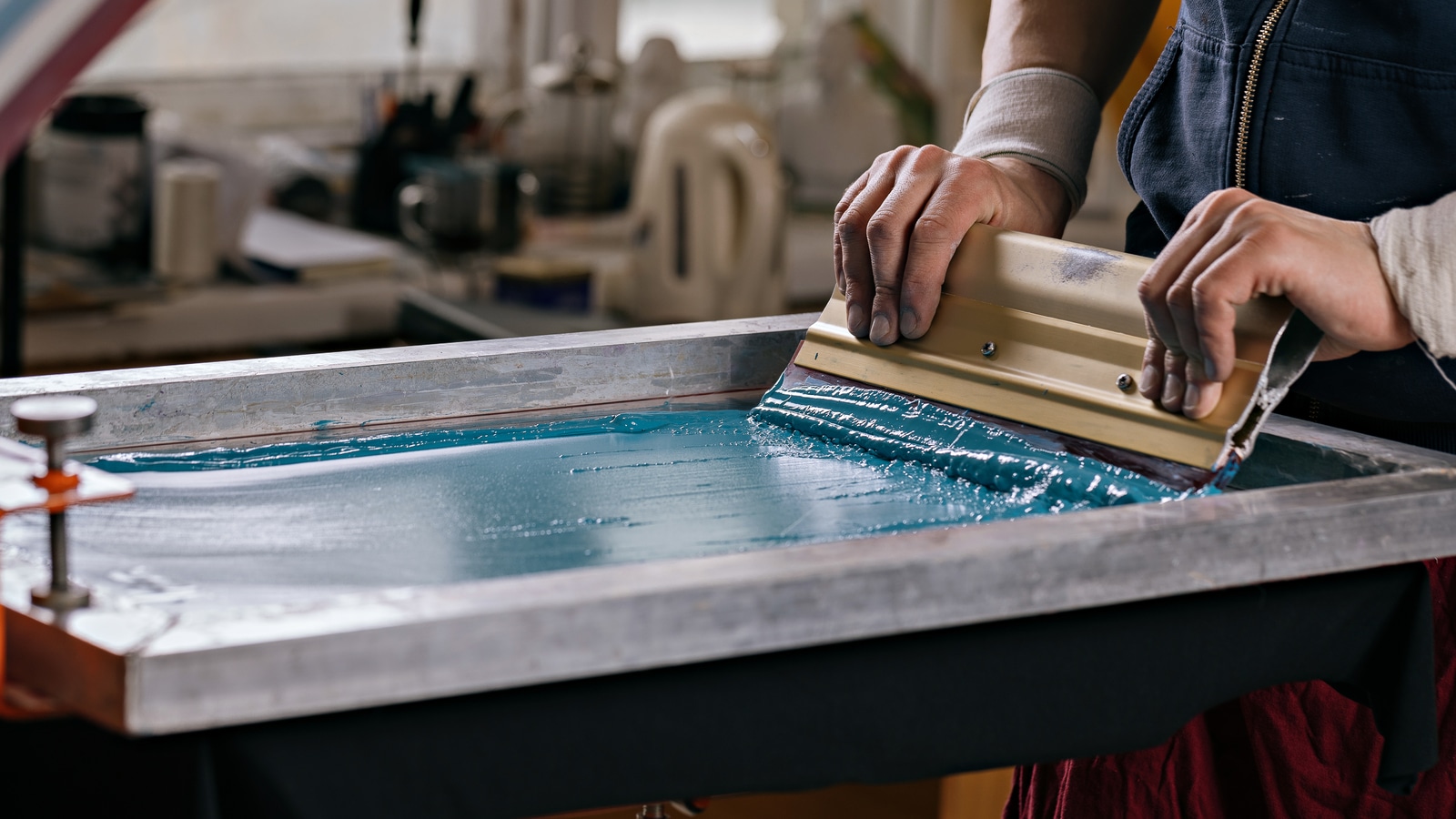Affordable Custom Screen Printing Services for Small Businesses
Affordable Custom Screen Printing Services for Small Businesses
Blog Article
Display Printing Uncovered: Whatever You Need to Understand About Tee Shirt and Garment Printing Strategies
If you've ever before questioned exactly how those lively layouts end up on your preferred t-shirts, you're in the right place. Screen printing is an interesting technique that incorporates art with technique, supplying unlimited opportunities for creativity. Understanding the basics, from devices to ink choices, can substantially affect your results. Ready to discover the important components that make screen publishing an art form? Allow's uncover the information that can elevate your jobs.
The Essentials of Screen Printing: How It Works
When you plunge into display printing, you'll find it's both a science and an art. At its core, screen printing entails producing a stencil, or display, that allows ink to pass through just in certain locations (screen printing kit). You start by selecting your design and preparing your display with a light-sensitive emulsion. As soon as you subject this emulsion to light, it solidifies, leaving your style as an unfavorable area.
Following, you'll mix your inks and prepare your printing surface area. Setting the display over the material, then make use of a squeegee to push ink with the display onto the garment. This process calls for precision, as you desire clear, lively prints. After printing, you'll treat the ink with warm, guaranteeing it sticks to the fabric and lasts via washes. Each step is crucial, and grasping them will certainly elevate your screen printing skills, transforming easy garments into one-of-a-kind, expressive pieces.
Sorts Of Screen Printing Strategies
As soon as you understand the basics of screen printing, it's time to explore the numerous techniques that can raise your designs. One popular method is conventional screen printing, where ink is pressed with a stenciled display. This method is wonderful for bold, dynamic colors. There's water-based ink printing, which supplies a softer feeling and is green, yet it calls for a various strategy to healing.
If you're intending for great information, consider discharge printing. This technique eliminates dye from the textile, leaving a soft, vintage look. Another option is plastisol printing, understood for its resilience and vibrant shades, making it a favorite for many brands. Experiment with halftone printing to create gradient impacts and intricate designs. Each method has its one-of-a-kind beauty, so don't be reluctant to try them out to discover what matches your style best!
Vital Equipment for Screen Printing
To achieve sensational results in screen printing, having the right tools is fundamental. You'll require a durable display printing framework, which holds the mesh that moves your layout onto the garment. Next, invest in premium mops; these are important for applying ink evenly across the display.
Picking the Right Inks and Products
When selecting inks and materials for screen printing, you need to consider the kind of ink that works finest for your job. Think of fabric compatibility to assure your layouts look last and great lengthy. Check out environmentally friendly ink options to make your printing procedure extra lasting.
Kinds Of Screen Inks
Selecting the best screen ink is vital for accomplishing dynamic, long lasting prints that meet your project's needs. There are numerous types of screen inks to analyze. Plastisol ink is prominent for its flexibility and simplicity of usage, supplying exceptional shade opacity on dark materials. Water-based ink, on the other hand, offers a softer feel and is environmentally friendly, making it suitable for those looking to decrease their ecological effect. Discharge inks get rid of dye from the material, causing a soft, vintage look yet call for certain handling. Lastly, specialty inks, such as metal or glow-in-the-dark, can add one-of-a-kind impacts to your designs. Review your project needs and select the ink that straightens finest with your desired outcome.

Textile Compatibility Factors To Consider
Comprehending material compatibility is important for accomplishing high-grade display prints, specifically given that different materials respond uniquely to various inks. When choosing inks, think about the textile kind-- cotton, polyester, or blends. For cotton, water-based inks work well, offering softness and breathability. Polyester, on the other hand, typically needs plastisol inks for far better attachment and vivid shades. You might require to utilize a combination of both kinds if you're publishing on blends. Always test your inks on sample textile to ensure they adhere correctly and maintain shade honesty. In addition, maintain in mind that textile weight and appearance can influence the last end result, so selecting the best ink and material combo is essential for your task's success.
Eco-Friendly Ink Options
Environment-friendly inks are coming to be a preferred selection for screen printers who want to minimize their environmental influence while preserving quality. When selecting inks, take into consideration water-based inks, which are much less hazardous and much easier to clean up contrasted to typical solvents.
Furthermore, seek inks made from renewable sources, such as soy or vegetable-based choices. By picking the appropriate inks and products, you'll not only produce stunning designs yet likewise add to a much more review sustainable printing process. Make the button, and your prints will show your commitment to the setting!
Preparing Your Design for Display Printing

Submit Layout Needs
To guarantee your design looks vivid and sharp on material, you'll need to pay close attention to submit format demands for display printing. Beginning with vector files like AI or EPS, as they can be scaled without losing quality. If you utilize raster images, select high-resolution files, such as TIFF or PNG, preferably at 300 DPI. Stay clear of making use of JPEGs, as they can lose quality when resized. Make certain your style has a clear background to avoid unwanted white edges on your prints. Keep shade settings in mind; CMYK is conventional for screen printing, so convert your RGB designs appropriately - screen printing kit. By adhering to these standards, you'll set your artwork up for a successful print.
Color Separation Techniques
Color separation is a necessary action in preparing your design for screen printing, and grasping it can substantially enhance your print quality. You'll need to damage your design into private shades, as each color calls for a separate display throughout printing. Beginning by recognizing all the colors in your style and produce layers each. You can make use of software program like Adobe Photoshop or Illustrator to separate and separate colors effectively. Be certain to save each layer as a separate documents, commonly in a format like TIFF or PSD. This precision not just ensures accurate shade representation yet additionally simplifies the printing procedure. By taking notice of color separation, you'll achieve dynamic and expert results in your screen-printed garments.
Resolution and Dimension
Accomplishing the very best cause display printing starts with guaranteeing your style has the appropriate resolution and dimension. Ideally, your art work should be at least 300 DPI (dots per inch) for sharp, clear prints. If you utilize lower resolution, your last item might look unprofessional and pixelated.
When it involves size, take into consideration the dimensions of your print location. Style your art work to match the final print dimension, preferably producing it in the actual dimensions you'll be publishing. This way, you'll avoid any kind of unexpected scaling issues.
Always examine your design in both vector and raster styles. Vector graphics can be scaled without shedding quality, making them ideal for screen printing. Preparing properly will ensure your layout looks outstanding on every garment!
Step-by-Step Display Printing Process
Screen printing is a dynamic procedure that allows you to develop dynamic layouts on different surfaces. To get begun, you'll need a display, emulsion, and your selected ink. First, prepare your display by cleansing it thoroughly. Next, apply the solution evenly and let it completely dry in a dark area. When completely dry, subject your screen to light with your style put on it, which will certainly solidify the solution where the light hits, creating a stencil - screen printing kit. read more
Put ink onto the display and use a squeegee to push the ink with the pattern onto the fabric. Raise the screen carefully and allow the print dry. You have actually effectively display printed your layout.
Tips for Effective Display Printing Projects
While you're diving right into your display printing jobs, keep in mind that prep work is crucial to success. Start by collecting all your materials-- inks, garments, squeegees, and displays. A tidy work space helps avoid unwanted errors, so clean prior to you start.
Following, verify your artwork is high-resolution and appropriately sized for your garment. Evaluate your screen for proper exposure and clean it thoroughly to avoid smudges. When blending your inks, follow the supplier's standards to attain the best consistency.
Throughout printing, apply even stress with your squeegee for consistent results. Don't hurry; take your time to confirm each print satisfies your standards. After printing, allow your garments completely dry totally prior to taking care of or packaging them.
Last but not least, constantly maintain an example of your work for future recommendation. In this manner, you can evaluate your progression and improve your strategies in time. Delighted printing!

Frequently Asked Questions
Just how Lengthy Does It Require To Establish a Display Printing Task?
Establishing a screen printing task normally takes about half an hour to an hour. You'll prepare the displays, mix inks, and readjust journalism. The moment differs based upon intricacy and experience, so stay organized!
Can I Publish on Various Textile Keys In Making Use Of the Exact Same Technique?
Yes, you can publish on various fabric types making use of the exact same method, but you'll require address to change your setups and inks. Some textiles take in ink in a different way, so experimenting warranties the finest results for each and every product.
What Are Typical Mistakes to Avoid in Screen Printing?
When screen printing, prevent usual mistakes like using the wrong ink, disregarding appropriate direct exposure times, or missing pre-press checks. Always test your configuration and maintain tidy screens to assure high quality outcomes each time.
Exactly How Can I Appropriately Clean and Keep My Screen Printing Tools?
To correctly tidy and maintain your display printing equipment, you must consistently wash displays with appropriate solvents, inspect squeegees for wear, and ensure all devices are kept completely dry and dust-free. Uniformity avoids pricey repairs and improves performance.
Is Display Printing Ecologically Pleasant Compared to Various Other Methods?
Display printing can be much more environmentally pleasant than various other techniques, especially if you make use of water-based inks and eco-conscious products. By choosing sustainable materials and techniques, you reduce waste and lessen your effect on the planet.
Screen Printing Uncovered: Whatever You Required to Know Concerning T-Shirt and Garment Printing Techniques
At its core, screen printing includes developing a pattern, or screen, that allows ink to pass with just in specific areas. Placement the screen over the fabric, after that use a squeegee to press ink via the display onto the garment. One prominent technique is standard screen printing, where ink is pushed with a stenciled screen.When choosing inks and products for display printing, you require to take right into account the type of ink that works best for your project.
Report this page